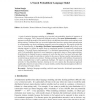91 search results - page 5 / 19 » What We Have Learned About Fighting Defects |
NIPS
2000
13 years 8 months ago
2000
A goal of statistical language modeling is to learn the joint probability function of sequences of words in a language. This is intrinsically difficult because of the curse of dim...
ECAL
1999
Springer
13 years 11 months ago
1999
Springer
How can we expect an A-life Agent to learn how to perform tasks when it is not told what those tasks are, and it is not provided any indication or feedback as to its performance? ...
ISMB
1993
13 years 8 months ago
1993
Thoughit has been possible in the past to learn to predict DNAhydration patterns from crystallographic data, there is ambiguity in the choice of training data (both in terms of th...
SIGUCCS
2003
ACM
14 years 21 days ago
2003
ACM
Working on a small campus has many advantages: Familiarity with the majority of faculty and staff, in-depth knowledge of how systems interact, adding the personal touch to each in...
Book
"Spatial structures and spatial reasoning are essential to perception and cognition. Much
day-to-day practical information is about what happens at certain spatial locations....

